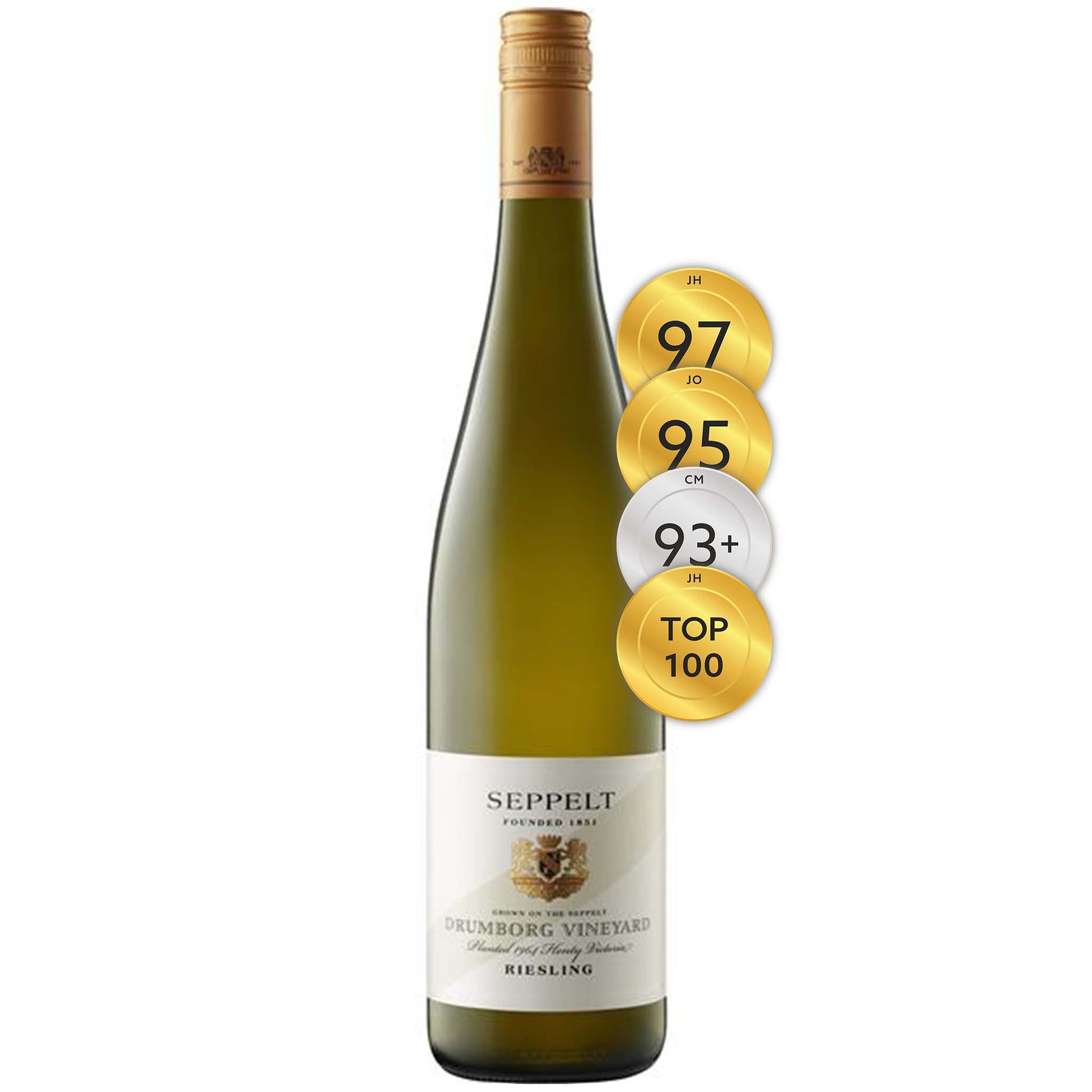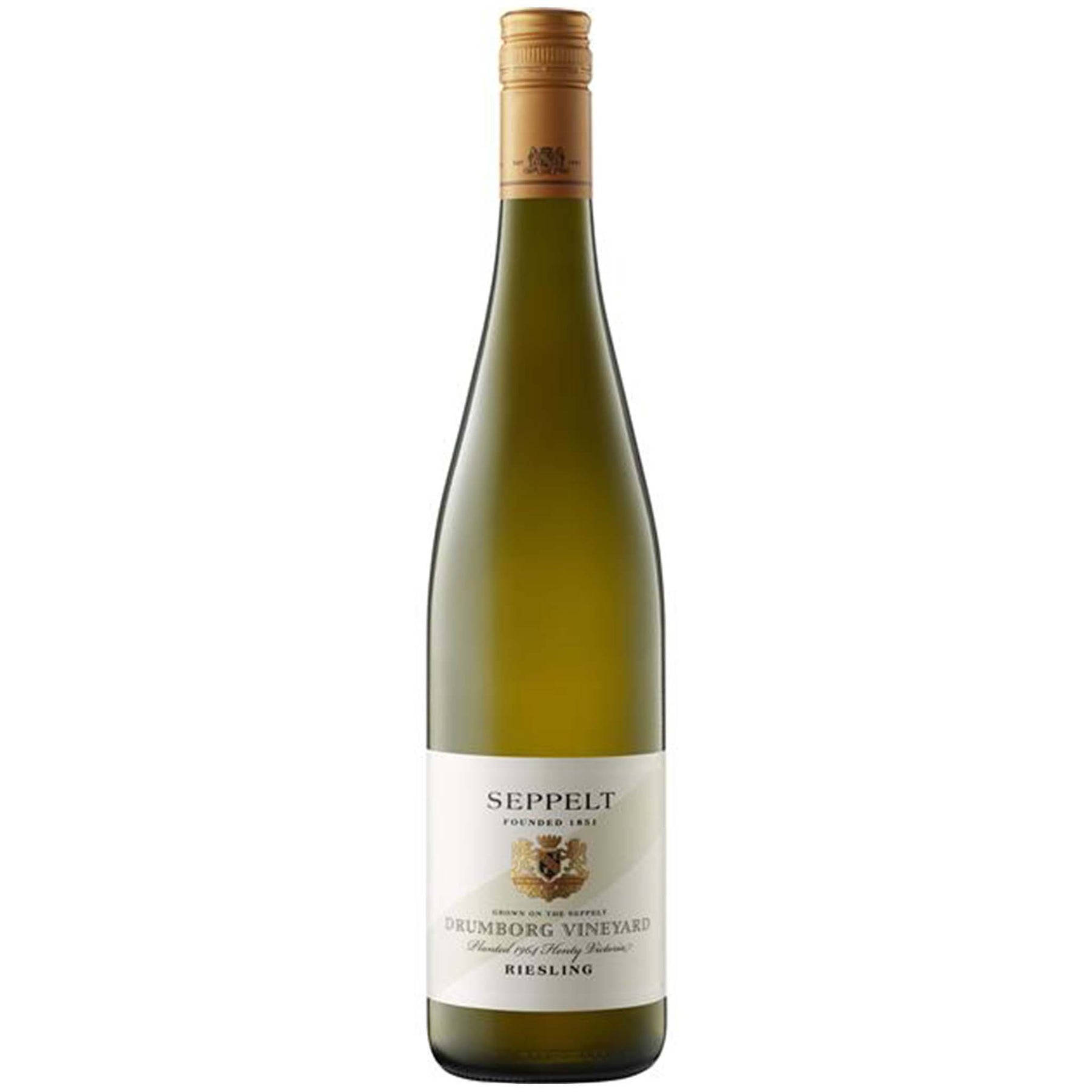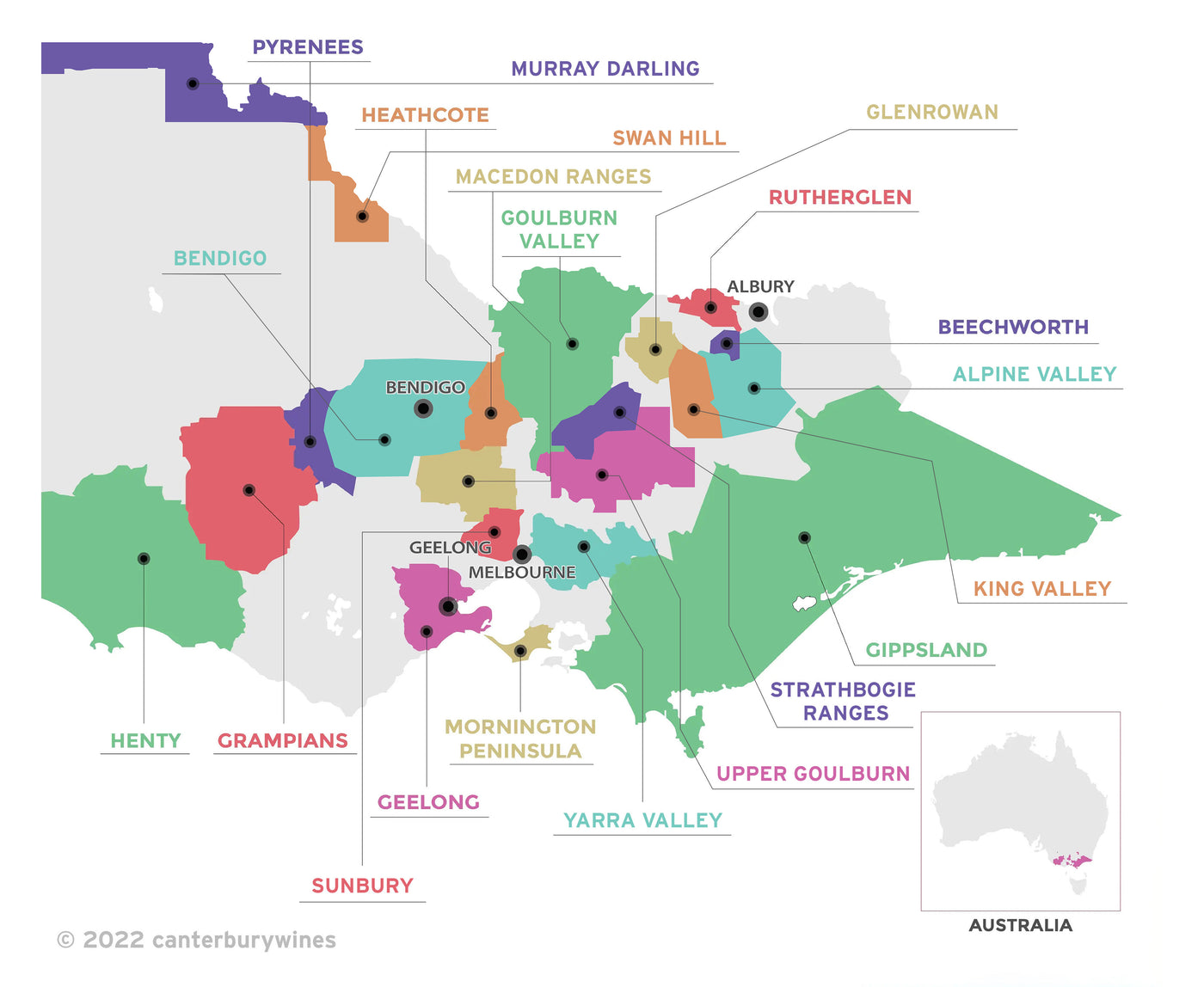

Seppelt Drumborg Vineyard Riesling 2013
Style: White Wine
Closure: Screwcap
Seppelt Drumborg Vineyard Riesling 2013
Warehouse
34 Redland Drive
Vermont VIC 3133
Australia
Critic Score: 97
Alcohol: 11.5%
Size: 750 ml
Drink by: 2035
James Halliday Top 100 Wines of 2013
"Drumborg riesling, first made in the '70s, is unique, with its mesmerisingly intense flavours, razor-like acidity, astonishing palate depth and seemingly endless length. It is austere and delicate in its youth, yet incredibly powerful with age. In a good vintage, it can live for decades." Toni Paterson MW
The Seppelt Drumborg Vineyard Riesling is sourced exclusively from the prized Drumborg Vineyard in Victoria's Henty region, one of the southern-most vineyards in mainland Australia. Planted in 1964 by Karl Seppelt and forged by icy winds from the Southern Ocean, the Drumborg vineyard produces a unique riesling that is much sought-after due to its fruit purity, structure, intensity of flavor and remarkable cellaring potential.
"This 2013 is a pearler. But not in an in-your-face way. It sneaks up on you. It's lemony, slatey, and intense with a great drive of acidity through the finish. That's the ageworthy bit, or the hard bit to negotiate as a young wine, take your pick. But there's all this sweet apple and pear-like flavour too, which gives it an open deliciousness up front. The sweetness is clear and noticeable, the acidity the driver of powerful length, and yet the two seem in harmony. This harmony gives the wine a delicacy, an elegance." Campbell Mattinson
"Drumborg riesling grapes are sourced from four blocks. The original, wide-spaced, 55-year-old plantings – known as Block 12 – consistently produce the best fruit and make up the backbone of the wine. Seppelt vineyard manager Larry Sadler, who has worked on the block for a quarter of a century, describes the fruit from these original vines as having lemon sherbet and Tahitian lime flavours, with purity, length, minerality and structure.
Block 2 was planted in 1976 and was grafted from rose cross to riesling in 2001. This portion adds pure lemon, acidity, chalkiness and length to the wine. Block 24, planted in 1989, contributes depth, grapefruit and floral aromatics. Block 21, established in 1990 and 2010, carries the classic elements of Drumborg's acid length, structure and flavour, despite being younger.
The fruit arrives at the winery with Baumé levels ranging between 11.1 and 12.4, acids between 9 and 11.5g/L, and pH around 3.0 or just below. The fruit is crushed, settled and cool fermented with the inclusion of a small portion of solids, and the fermentation is stopped just before dryness. The simple, almost hands-off approach of the winemaking allows for the vineyard signature to be fully expressed." Toni Paterson MW
Expert reviews
"Drumborg Vineyard riesling with a slither of sweetness. From the great Drumborg Vineyard in the south-west Victorian region of Henty. This wasn't made by winemaker Jo Marsh, she had moved on by 2013, but I like her comment on what it's like working with riesling from Drumborg. 'It's always a special day when the Drumborg Riesling comes in', she said to me in 2010. 'We all tip-toe around the winery that day. It's a vineyard that makes us look good, and we're always really nervous about stuffing it up.'
While the bouquet is fresh, flowery and clean, it is on the palate that it bursts into joyful song, with a surge of lime, lemon and passionfruit that propels the flavours through to the finish and aftertaste, the minerally acidity largely unseen, but guaranteeing a 20-year drinking window. Drink by: 2030." James Halliday, Halliday Wine Companion - 97 points and Top 100 Wines of 2013
"Very fine, elegant and tightly focused, with a scent of white flowers, sliced apple and lime juice backed by nuances of fresh pear, chalk and mineral. It's long and limey, with a pure, crystalline expression of crunchy citrus and apple-like fruit extending long towards a savoury finish of lemony acids underpinned by a lick of wet slate. Drink: 2025-2033." Jeremy Oliver - 95 points
This 2013 is a pearler. But not in an in-your-face way. It sneaks up on you. It's lemony, slatey, and intense with a great drive of acidity through the finish. That's the ageworthy bit, or the hard bit to negotiate as a young wine, take your pick. But there's all this sweet apple and pear-like flavour too, which gives it an open deliciousness up front. The sweetness is clear and noticeable, the acidity the driver of powerful length, and yet the two seem in harmony. This harmony gives the wine a delicacy, an elegance. Drink: 2013-2025+." Campbell Mattinson, The Wine Front – 93+ points
Awards
James Halliday Top 100 Wines of 2013
Drumborg vineyard

The Drumborg range of wines are sourced exclusively from the prized Drumborg Vineyard in Victoria's Henty region, one of Australia's leading cool climate regions and southern-most vineyard in mainland Australia. Riesling was the first variety planted at Drumborg in 1964 by Karl Seppelt. The vineyard is swept by icy winds from the Southern Ocean and produces wines that are renowned for their fruit purity, structure and intensity of flavor.
"The half-century-old vineyard has been described as remarkable, even mystical, regarding its capacity to produce wines of incredible beauty despite the rugged, challenging and sometimes precarious, nature of the climate.
Blustering winds from the southern Indian Ocean and long, wet winters are not what springs to mind when selecting new vineyard land. But that is precisely what was chosen by the Seppelts. Third-generation family member Karl Seppelt graduated from Roseworthy and began managing the vineyards at the family winery in South Australia. B Seppelt & Sons were well known for their fortified wines, however, the market of the day was changing and there was a new need for table wine grapes.
Fortunately, B Seppelt & Sons owned a winery at Great Western in Victoria, and a gently undulating 190ha land parcel was purchased in 1964 at Drumborg, 200km from the winery. It was cooler and had more rain than Great Western, and its southerly aspect exposed it to the full weight of the south-westerly weather fronts. There were, unsurprisingly, no other vineyards around. One suspects that the Great Western winery's focus on sparkling wines was a factor in choosing such a cool site. That said, the Seppelts were well before their time, embarking on cool-climate viticulture before it was fashionable.
Drumborg is now one of a handful of vineyards in the region known as Henty. There are many different varieties planted at the site, including chardonnay and pinot noir, though riesling was the first variety planted. The original clone is unknown though it is suspected to be GM198 imported from Geisenheim."
Seppelt vineyard manager Larry Sadler, who has worked on the block for a quarter of a century, takes his custodianship of the vineyard very seriously. 'Tasting fruit through the full length of the ripening process is one of the great privileges of managing the Drumborg Vineyard. I taste the grapes from before the birds are interested – when the acid is eye-watering; through the waves of ripening, until the last of the golden-orange berries, left after harvest, have been cleaned from the vines.'
There have been only five vineyard managers since the 1960s, despite the multiple changes of ownership. Before Sadler, Allen McLean – a true storyteller – worked the block for more than 30 years. It's clear that the place gets into one's soul, even if it's whipped there by the wind.
There is a long list of winemakers who have been part of the Drumborg story but none more than Ian McKenzie. Emma Wood, Jo Marsh and Adam Carnaby have been among the recent custodians." Toni Paterson MW, Gourmet Traveller Wine

About the winery

Seppelt is one of Australia's most historic wine producers. Few Australian wineries have carved such a distinguished name for both still and sparkling wines. Not only is Seppelt a pioneer of white and red sparkling wine in Australia, but it also crafts some of the country's most collected table wines and has helped pave the way for cool climate styles in Australia.
Seppelt wines capture a diversity of Victorian terroirs. It sources fruit from vineyards situated in the cool Grampians, the Henty Hinterland, Heathcote and Bendigo. Each region offers parcels of unique character and distinctive regional typicity. The backbone of Seppelt's portfolio are the three iconic wines; St Peters Shiraz, Drumborg Riesling and the Show Sparkling Limited Release Shiraz, which is made only in exceptional years.
The Seppelt Great Western winery traces its history back to 1865 when it was founded by Joseph Best – his brother also notably planted nearby. The vine material was sourced from St Peters Vineyard, which was the region's first vineyard planted just two years earlier in 1863. Best commissioned gold miners to dig the underground tunnels or drives that the winery is famous for. Those drives were expanded by Hans Irvine who purchased the estate after Best's sudden death in 1887 at the age of 57.
Irvine also expanded plantings and employed the ex-winemaker from Pommery, Charles Pierlot. At that time, some sparkling wine was being made locally, but it was Irvine's commitment that established the strong tradition in the region. That included what is often credited as the first Sparkling Burgundy, as it used to be called, made from red grapes, while sparkling whites were made from ondenc (once a common Bordeaux grape but now mainly grown in Gaillac), which has naturally high acidity.
By the early 1900s, there were over 1.6 kilometres of drives for cellaring and Great Western was Australia's largest wine producer. The operation was sold to Benno Seppelt in 1918, who added the family name and expanded the business further.
Fast forward to today and the winery is part of the Treasury Wine Estates portfolio, but the traditions are still very much alive. Winemaker Clare Dry, who spent 13 years crafting wines in South Australia, took over from Adam Carnaby from the 2021 vintage.

Victoria
Victoria is home to more than 800 wineries across 21 wine regions. The regions are Alpine Valley, Beechworth, Bendigo, Geelong, Gippsland, Glenrowan, Goulburn Valley, Grampians, Heathcote, Henty, King Valley, Macedon Ranges, Mornington Peninsula, Murray Darling, Pyrenees, Rutherglen, Strathbogie Ranges, Sunbury, Swan Hill, Upper Goulburn and Yarra Valley.
Victoria's first vines were planted at Yering in the Yarra Valley in 1838. By 1868 over 3,000 acres had been planted in Victoria, establishing Victoria as the premier wine State of the day. Today, the original vineyards planted at Best's Wines are among the oldest and rarest pre-phylloxera plantings in the world.
Victoria's climate varies from hot and dry in the north to cool in the south and each wine region specialises in different varietals. For example, Rutherglen in the north is famous for its opulent Muscats and Topaque and bold reds, while the many cooler climate regions near Melbourne produce world class Chardonnay and pinot Noir. Victoria is truly a wine lover's playground.

